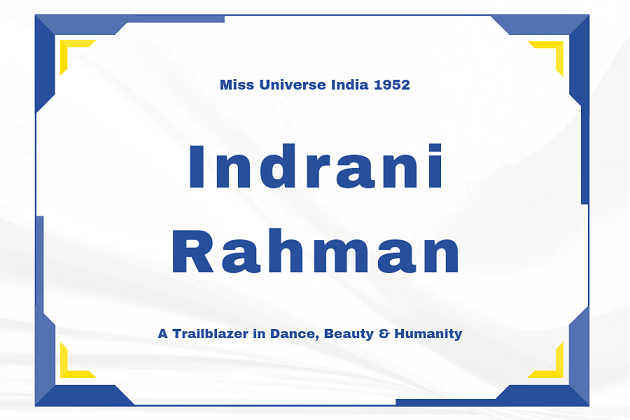Introduction
Indrani Rahman, a name synonymous with grace, talent, and cultural diplomacy, was a remarkable woman whose life was nothing short of extraordinary. Born on September 19, 1930, in Chennai (then Madras), she was destined to be a trailblazer. Her legacy encompasses her groundbreaking achievements in the realms of beauty, dance, and social activism. From being the first Miss India in 1952 to popularizing the classical dance form of Odissi in the West, she left an indelible mark on the world. In this blog, we will delve into the captivating journey of Indrani Rahman, a woman who seamlessly blended Indian and American influences, transcending cultural boundaries.
Early Life and Diverse Upbringing
Indrani Rahman’s life was shaped by a unique and multicultural upbringing. Born to Ramalal Balram Bajpai, an Indian chemist who had studied in the United States, and Esther Luella Sherman, an American woman who converted to Hinduism and adopted the name Ragini Devi, Indrani was exposed to both Indian and Western cultures from a very young age.
Her parents moved to India in the 1920s, where her father held various important positions, including the Consul General of India in New York. Meanwhile, her mother Ragini Devi, an American by birth, developed a fervent passion for Indian classical dance and was taught by renowned dancers Jetti Tayamma and Gauri Amma. Her mother’s dedication to dance and her commitment to reviving classical art forms had a profound influence on Indrani’s upbringing.
Early Exposure to Dance
Indrani Rahman’s initiation into the world of dance was a natural progression. She began her dance training within her mother’s company, learning the intricacies of Bharata Natyam, one of the most celebrated Indian classical dance forms. Additionally, she was under the tutelage of various eminent gurus like Chokkalingam Pillai, Korada Narasimha Rao, and Deba Prasad Das. Her devotion to the art led her to master an impressive array of dance forms, including Bharata Natyam, Kuchipudi, Kathakali, and Odissi. This diverse training was a testament to her dedication and unyielding spirit.
Miss India 1952: A Landmark Achievement
Indrani Rahman’s remarkable journey took a turn towards mainstream recognition when she participated in the Miss India pageant in 1952. Her participation in beauty pageants was encouraged by her mother, who believed that they would not only bolster her confidence but also provide her with much-needed exposure. It is worth noting that at the time, beauty pageants were considered unconventional for married women and mothers. Her decision to participate was a bold one.
Indrani Rahman’s beauty, grace, and charisma captivated the judges, leading to her being crowned as the first Miss India in 1952. This historic win catapulted her to the international stage as she represented India at the inaugural Miss Universe pageant in Long Beach, California. Her journey on the global stage was marked by a series of challenges, including adapting to a new culture, confronting racial discrimination, and overcoming homesickness. Her position as the first Indian representative at an international beauty pageant came with the added responsibility of showcasing her country’s rich culture and beauty.
Indrani Rahman not only fulfilled these responsibilities with grace but also left an indelible mark on the pageant. In the evening gown competition, she chose to wear a traditional sari, a decision that was both bold and unique at the time. For the talent round, she performed a classical dance, showcasing her artistic prowess and cultural heritage. Her performance was met with admiration and appreciation, earning her the title of Miss Congeniality alongside Miss Montana.
This historic win marked her as the first Asian woman to clinch a title at the Miss Universe pageant. Her achievements were celebrated not only in India but also by the international community. Indrani’s journey was a testament to her determination, breaking barriers and challenging norms, while simultaneously spreading the message of unity and tolerance.
The Dance Maestro: Popularizing Odissi
After her historic win, Indrani Rahman continued to make history, this time in the world of dance. She pursued a multifaceted dance career that began with Bharata Natyam and Kuchipudi. However, her foray into Odissi was a transformative experience. Dr. Charles Fabri, a prominent dance and art critic, introduced her to Odissi, an ancient dance form from Orissa. Under the guidance of Guru Deba Prasad Das, she mastered Odissi and became the first professional dancer to perform this classical art form. Indrani’s passion for Odissi led her to popularize it not only in India but also on the global stage, preserving and promoting this timeless heritage.
Indrani Rahman’s talents extended beyond the traditional dance forms. She delved into Kathakali, a dance style she learned from her mother, and infused it with her unique innovations. Her explorations didn’t stop there; she dabbled in other dance forms, including Manipuri and various folk dances, further expanding her repertoire. Her performances were both solo and collaborative, with her mother and her daughter Sukanya Rahman, forming a unique trio spanning three generations of dancers.
Global Cultural Ambassador
Indrani Rahman’s career as a dancer knew no boundaries. She took her art to prestigious venues worldwide, including Carnegie Hall, Lincoln Center, Kennedy Center, Royal Albert Hall, and the Bolshoi Theatre. Her participation in various international festivals and conferences on dance and culture further solidified her status as a global cultural ambassador.
Awards and Accolades
Indrani Rahman’s contribution to the world of Indian dance did not go unnoticed. Her remarkable talents were recognized with numerous awards and honors, including the Padma Shri in 1969 and the Sangeet Natak Akademi Award in 1981. Her impact was also acknowledged on the international stage, as she received the Taraknath Das Award from Columbia University in 1983. Her life’s work not only enriched the world of Indian classical dance but also contributed significantly to the global understanding of India’s rich cultural heritage.
Life Beyond the Stage
Indrani Rahman’s life was a testament to her unwavering commitment to art, culture, and humanitarian causes. Despite her many accomplishments on the global stage, she continued to inspire and impact lives in various other ways.
Promoting Peace and Harmony
Indrani Rahman’s background was a testament to her belief in the importance of unity and tolerance among different religions and cultures. Born to a Hindu father and an American mother who converted to Hinduism, she married Habib Rahman, a Muslim architect. Her life embodied the idea that love and understanding can transcend religious and cultural differences. She performed for various world leaders, including Queen Elizabeth II, Mao Zedong, Fidel Castro, and John F. Kennedy, using her art to spread the message of love, tolerance, and harmony.
Empowering Women and Girls
Indrani Rahman was a pioneer who broke down stereotypes regarding the role of women, particularly married women and mothers, in the 1950s. She encouraged her daughter, Sukanya Rahman, to follow her passion for dance, ultimately forming a mother-daughter duo that enthralled audiences. In addition to her personal journey, she founded the Indrani Rahman Foundation, dedicated to providing scholarships and grants to young female dancers, further promoting women’s empowerment.
Helping the Underprivileged
Indrani Rahman was not only an artist but also a compassionate humanitarian. She generously supported various charities and organizations working towards the betterment of the underprivileged. Her contributions spanned a wide range of causes, including famine relief, healthcare, education, environmental protection, and animal welfare. Furthermore, she adopted several orphaned children, providing them with not only the essentials of life but also opportunities for growth and education.
Continued Dedication
Indrani Rahman’s passion for dance and her commitment to social and charitable causes continued even after her move to New York in 1976. She established the Indrani School of Dance in New York, where she trained countless students and disciples. Her influence extended to academia as well, with her serving as a visiting professor at renowned universities such as Harvard, Yale, Columbia, and New York University. Her extensive experience and knowledge enriched the lives of her students and the academic institutions she was associated with.
A Legacy that Lives On
Indrani Rahman’s remarkable journey came to a poignant conclusion when she passed away on February 5, 1999, in New York, at the age of 68. Her death marked the end of an era, but her legacy continues to live on. Her contributions to the world of Indian classical dance, her remarkable achievements in beauty pageants, and her dedication to social causes have left an indelible mark on the world. She was a true ambassador of India’s culture and diversity, a trailblazer for women’s empowerment, and a symbol of unity and tolerance.
Conclusion
Indrani Rahman’s life story is a testament to the remarkable achievements of a woman who seamlessly bridged cultures, challenged norms, and made an indelible mark on the world. From her historic win as the first Miss India in 1952 to her pioneering efforts in popularizing Odissi and her dedication to humanitarian causes, she remains an inspiration to all. Her legacy is not merely a page in history but a beacon that continues to guide and inspire generations, reminding us that the pursuit of one’s passions, coupled with compassion and commitment, can change the world. Indrani Rahman, a trailblazer in dance, beauty, and humanity, will forever remain etched in our hearts and minds as a true legend.
You can also read about “Neha Kapur (Miss Universe India 2006): From Miss India to Fashion Designer and Beyond“.

